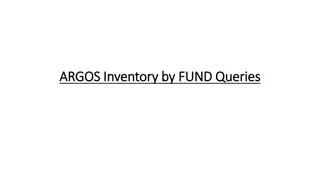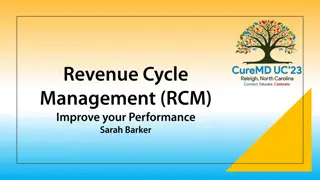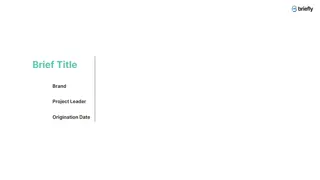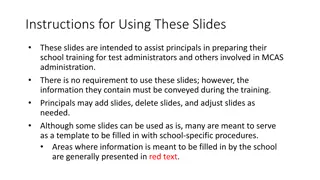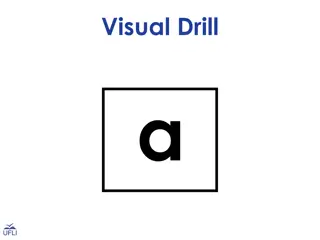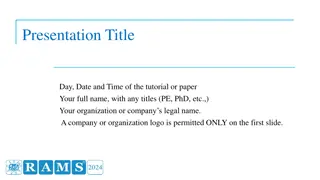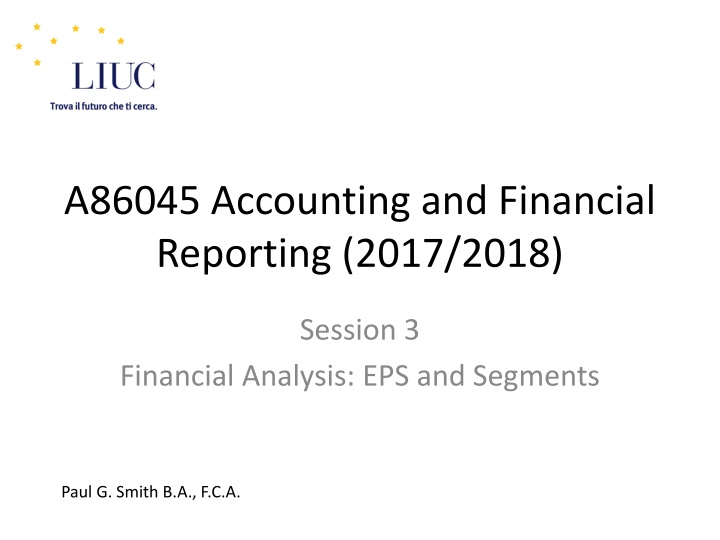
Financial Analysis Techniques and Segments Overview
Explore financial analysis techniques such as ratio analysis, trend analysis, and common size analysis, along with understanding EPS calculations and segment disclosures as per IFRS standards. Gain insights into profitability, liquidity, efficiency, and investment assessments in this comprehensive session.
Download Presentation

Please find below an Image/Link to download the presentation.
The content on the website is provided AS IS for your information and personal use only. It may not be sold, licensed, or shared on other websites without obtaining consent from the author. If you encounter any issues during the download, it is possible that the publisher has removed the file from their server.
You are allowed to download the files provided on this website for personal or commercial use, subject to the condition that they are used lawfully. All files are the property of their respective owners.
The content on the website is provided AS IS for your information and personal use only. It may not be sold, licensed, or shared on other websites without obtaining consent from the author.
E N D
Presentation Transcript
A86045 Accounting and Financial Reporting (2017/2018) Session 3 Financial Analysis: EPS and Segments Paul G. Smith B.A., F.C.A.
SESSION 3 OBJECTIVES & OVERVIEW A 86045 Accounting and Financial Reporting 2
Session 3 Overview Mins Session overview and objectives 5 Session 2 recap 25 Earnings per share (EPS) 15 Segmental Analysis 15 Research assignment RA2 Presentations (5 x 10) 50 Common size analysis 15 Required reading and assignment for next session 5 Summary, overview of session 4 and validation 5 135 A 86045 Accounting and Financial Reporting 3
Course Overview 1. Financial reporting under IFRS 14. Construction contracts 2. Financial analysis: Ratio analysis 15. Other Non-financial liabilities 3. Financial analysis: Segments and EPS 16. Review session PGS 4. Review session 17. Mid term test 5. Revenues 18. Financial Instruments 1 6. Costs and expenses 19. Financial Instruments 2 PGS 7. Taxation - Direct and Indirect 20. Review session 8. Non-current assets - Intangible assets 21. Cash Flow Statement 9. Non-current assets - Tangible assets 22. Group accounts/Business comb PT 10. Financial leases 23. Review session 11. Impairment of assets 24. Review session PGS 12. Review session 25. Final test 13. Inventories PT A 86045 Accounting and Financial Reporting 4
Objectives of Session 3 At the end of this session session students will be able to: Apply the basic techniques of financial analysis Ratio analysis Trend analysis Common size analysis Performa high level assessment of a company s: Profitability Liquidity Efficiency Investment CalculateBasic EPS, Fully diluted EPS and the weighted average of shares outstanding Understand what an Operating segment is and a Reportable segment is and the disclosures required by IFRS 8 A 86045 Accounting and Financial Reporting 5
SESSION 2 RECAP AND PRE-WORK A 86045 Accounting and Financial Reporting 6
Session 2 summary Recap Session 1 and the 4 basic financial statements Financial analysis Ratio analysis (profitability, liquidity, efficiency and investment) Ratio, trend and common size analysis Reading, research and assignment for next session A 86045 Accounting and Financial Reporting 7
Required Reading and research assignment Reading Melville Chapter 22 Ratio Analysis (26 pages) IFRS None Exercises Melville Exercises 22.1 22.6 Melville On-line multiple choice questions for the above chapter Exercise EX 2 Financial Analysis Exercises Research assignment European companies in the Top Global 100 companies using IFRS RA 2 Data collection template for chosen companies Calculate the profitability, liquidity, efficiency and investment ratios Perform a three year trend analysis of the Profit and loss accounts Perform a two year comparison of the statement of financial position Identify reasons for significant fluctuations from the Company s Annual Report A 86045 Accounting and Financial Reporting 8
RATIO ANALYSIS A 86045 Accounting and Financial Reporting 9
Ratio analysis Profitability Gross margin Operating margin Net profit margin Return on capital employed (ROCE) Return on equity (ROE) Liquidity Current ratio Quick ratio (acid test) Efficiency Asset turnover Inventory turnover (DOI) Accounts receivable turnover (DSO) Accounts payable turnover (DPO) Investment ratios Earnings per share (EPS) Price earnings ratio (P/E) Dividend cover Dividend yield Capital Gearing/Leverage Interest cover Ratios are useful to understand a company s situation. However, they can be even more useful if we compare and confront them both over time and with other companies. Ratios can also help understand what is going on within a business through segmental analysis A 86045 Accounting and Financial Reporting 10
TREND ANALYSIS A 86045 Accounting and Financial Reporting 11
Trend analysis 2013 2012 2011 Profitability Gross margin Operating margin Net profit margin Return on capital employed (ROCE) Return on equity (ROE) Liquidity Current ratio Quick ratio (acid test) Efficiency Asset turnover Inventory turnover /DOI Accounts receivable turnover/DSO Accounts payable turnover/DPO Investment ratios Earnings per share (EPS) Price earnings ratio (P/E) Dividend cover Dividend yield Capital Gearing/Leverage Interest cover A 86045 Accounting and Financial Reporting 12
COMMON SIZE ANALYSIS A 86045 Accounting and Financial Reporting 13
Common size analysis Company 1 Company 2 Company 3 Profitability Gross margin Operating margin Net profit margin Return on capital employed (ROCE) Return on equity (ROE) Liquidity Current ratio Quick ratio (acid test) Efficiency Asset turnover Inventory turnover /DOI Accounts receivable turnover/DSO Accounts payable turnover/DPO Investment ratios Earnings per share (EPS) Price earnings ratio (P/E) Dividend cover Dividend yield Capital Gearing/Leverage Interest cover A 86045 Accounting and Financial Reporting 14
EARNING PER SHARE IAS 33 A 86045 Accounting and Financial Reporting 15
Significance of EPS EPS is widely used as a means of assessing a company's financial performance EPS feeds into the Price/Earnings ratio, which is an important indicator of investment potential EPS is the only ratio which is defined by an international standard (IAS33) A 86045 Accounting and Financial Reporting 16
Scope of IAS33 IAS33 applies only to companies whose shares are publicly traded. The consolidated financial statements of a group of companies disclose EPS for the group as a whole. A 86045 Accounting and Financial Reporting 17
Calculation of Basic EPS Profit or loss for the period attributable to ordinary shareholders* Weighted average number of ordinary shares outstanding during the period * i.e. Excludes profit or loss attributable to non-controlling interests. Also after any preference dividends on preference shares A 86045 Accounting and Financial Reporting 18
Basic EPS - example Continuing operations ooos 1. The company s issued share capital consists of 500,000 10% Preference shares of 1 each and one million ordinary shares of 1 each. Profit before tax 650 Taxation (200) Profit from continuing operations 450 Discontinued operations Profit from discontinued operations 70 2. A preference dividend of 50,000 was paid during the year. Profit for the period 520 520,000 - 50,000 EPS = 47p per share 1,000,000 450,000 - 50,000 = 40p per share EPS - Continuing operations 1,000,000 A 86045 Accounting and Financial Reporting 19
Calculation of the weighted average number of shares a). No. of shares outstanding at beginning of the period plus b). No. of shares issued during the period x a time weighting factor less c). No. of any shares bought back by the company (if any) x time weighting factor. A 86045 Accounting and Financial Reporting 20
Example Weighted average calculation On 1 January 2017, a company's issued share capital consisted of 60,000 ordinary 1 shares. On 1 March 2017, the company issued 30,000 ordinary shares. On 1 October 2017, the company bought back 10,000 ordinary shares. Both the share issue and the buy-back were made at full market price. Calculate the weighted average number of ordinary shares outstanding in the year to 31 December 2017. 60,000 + (30,000 x 10/12) (10,000 x 3/12) = 82,500 shares. OR (60,000 x 2/12) + (90,000 x 7/12) + (80,000 x 3/12) = 82,500 shares. Source: Melville, Alan. International Financial Reporting, 6th Edition. Pearson (Intl), 20170629. VitalBook file. A 86045 Accounting and Financial Reporting 21
Calculation of Diluted EPS Diluted EPS is the EPS figure that would arise if all dilutive potential ordinary shares were issued. Potential ordinary shares generally occur in connection with convertible loan stocks and share options. Shares are regarded as dilutive if the effect of their issue would be to reduce basic EPS. Diluted EPS must be disclosed for the previous accounting period as well as for the current accounting period. A 86045 Accounting and Financial Reporting 22
IAS33 presentation and disclosure requirements Basic EPS and diluted EPS must be presented in the statement of comprehensive income. EPS figures must be presented even if they are negative (i.e. if there is a loss per share). The earnings figures used in EPS calculations must be disclosed and reconciled to the profit or loss shown in the financial statements. The weighted average number of shares used in the calculation of basic EPS and diluted EPS must be disclosed and reconciled to each other. A 86045 Accounting and Financial Reporting 23
SEGMENT ANALYSIS IFRS 8 A 86045 Accounting and Financial Reporting 24
Segmental Analysis IFRS 8 Definition of an operating segment An Operating Segment is a component of an entity: a) That engages in business activities from which it may earn revenues and incur expenses b) Whose operating results are regularly reviewed by the company s Chief Operating Decision Maker to make decisions about resources to be allocated to the segment and to assess its performance c) For which discrete financial information is available A 86045 Accounting and Financial Reporting 25
Reportable Segment AA single or combined operating segment which meets any of the following quantitative thresholds: I. Revenue is at least 10% of total revenue II. Profit or loss is at least 10% of combined profit or loss of all reportable segments III. Assets are at least 10% of total assets If reportable segments do not cover at least 75% of total external revenues, additional segments must be identified until this threshold is met. A 86045 Accounting and Financial Reporting 26
Disclosures required by IFRS8 General information Information about reportable segments Reconciliations Entity-wide information A 86045 Accounting and Financial Reporting 27
General information An entity should disclose the factors used to identify its reportable segments and the types of products or services from which each reportable segment earns its revenues. The way in which the entity is organised internally should be made clear. The entity should also disclose whether or not any operating segments have been combined for segment reporting purposes. A 86045 Accounting and Financial Reporting 28
Information about reportable segments Segment profit or loss and, if provided to the chief operating decision maker: Segment total assets Segment total liabilities Segment external and internal revenue Segment interest expense and interest revenue Segment depreciation and amortisation Segment tax expense or income Segment non-cash items other than depreciation and amortisation (if material) Segment additions to non-current assets A 86045 Accounting and Financial Reporting 29
Reconciliations total revenue of reportable segments to the entity's revenue total profit or loss of reportable segments to the entity's profit or loss total assets of reportable segments to the entity's assets total liabilities of reportable segments to the entity's liabilities A 86045 Accounting and Financial Reporting 30
Entity-wide information revenue for each product or service (or each group of products or services) revenue and non-current assets for the entity's home country and (in total) for all foreign countries if any single customer accounts for at least 10% of total external revenue, the amount of revenue derived from each such "major customer" A 86045 Accounting and Financial Reporting 31
SM 1 - Segmental analysis millions Group Wines & Spirits Fashion & Leather Goods Perfumes & Cosmetics Watches & Jewelry Selective Retailing Other Holding Companies Eliminations and not allocated Total Revenue Intra-group sales Total revenue Cost of Sales 30,638 3,945 10,796 3,368 548 3,916 2,720 9,511 298 14 312 30,638 28 32 62 23 (707) (707) 0 3,973 10,828 2,782 9,534 30,638 (10,801) 19,837 (11,744) (2,373) Marketing and selling expenses General and administrative expenses Income (loss) from JVs and associates Profit from recurring operations Other operating income and expenses (5) 5,715 (284) 5,431 (115) 3,062 2,947 (2,273) 6,105 (457) 5,648 1,147 (34) 1,113 3,189 (110) 3,079 415 (14) 401 283 882 (74) 808 (162) (53) (215) (39) 5,715 (284) 5,431 1 Operating profit 284 (39) Cost of net financial debt Other financial income and expenses Net financial income and expenses Income taxes Net profit before minority interests Minority interests Net profit, group share Gross Margin Operating margin Net profit margin 65% 18% 20% 28% 28% 10% 10% 8% -69% 6% 18% Intangible assets and goodwill Property, plant & equipment Inventories Other operating assets Total assets 21,841 10,387 9,475 11,659 53,362 3,758 2,339 4,567 1,340 12,004 7,242 2,165 1,561 781 11,749 1,183 477 398 664 2,722 5,635 425 1,244 635 7,939 3,161 1,415 1,668 668 6,912 862 3,566 239 608 5,275 21,841 10,387 9,475 11,659 53,362 (202) 6,963 6,761 Operating profit on total assets 10% 9% 26% 15% 4% 12% -4% -1% 10% A 86045 Accounting and Financial Reporting 32
RESEARCH ASSIGNMENT 2 A 86045 Accounting and Financial Reporting 33
Research assignment 2 Barclays L Oreal Nestl Siemens Vodafone 1. Calculate the profitability, liquidity, efficiency and investment ratios 2. Perform a three year trend analysis of the Profit and loss accounts 3. Perform a two year comparison of the statement of financial position 4. Identify reasons for significant fluctuations from the Company s Annual Report A 86045 Accounting and Financial Reporting 34
SM 2 RA 2 Template Research assignment template Company % Change On PY % Change On PY % Change On PY 2016 2015 2014 2016 millions 2015 millions Income Statement Statement of financial position Non-current assets Goodwill Intangible assets Property, plant & equipment Investments Deferred taxes Other millions millions millions Net sales Other revenues #DIV/0! #DIV/0! #DIV/0! #DIV/0! #DIV/0! #DIV/0! #DIV/0! #DIV/0! #DIV/0! #DIV/0! #DIV/0! #DIV/0! #DIV/0! #DIV/0! #DIV/0! #DIV/0! #DIV/0! #DIV/0! #DIV/0! #DIV/0! #DIV/0! #DIV/0! #DIV/0! #DIV/0! #DIV/0! #DIV/0! #DIV/0! #DIV/0! #DIV/0! #DIV/0! #DIV/0! #DIV/0! #DIV/0! #DIV/0! #DIV/0! #DIV/0! #DIV/0! #DIV/0! #DIV/0! #DIV/0! #DIV/0! #DIV/0! #DIV/0! Total revenues 0 0 0 Cost of sales Gross profit 0 0 0 Operating expenses Research & development Selling, general and administrative expenses Depreciation, ammortization and provisions Other income (expense) 0 0 Current assets Inventories/Long-term contracts Trade receivables Other current assets Short-term investments Cash and cash equivalents Assets held for disposal #DIV/0! #DIV/0! #DIV/0! #DIV/0! #DIV/0! #DIV/0! #DIV/0! Operating profit 0 0 0 Finance income (expense) Share of result of associated companies Pre-tax profit 0 0 0 Income tax 0 0 Net profit continuing operations 0 0 0 Discontinued operations Total assets #DIV/0! 0 0 Net profit 0 0 0 Profitability Gross margin (Gross profit/Revenues) Operating margin (Operating profit/Revenues) Net profit margin (Net profit/Revenues) Return on equity (Net profit/Shareholders' equity) Return on Capital employed (PBIT/Shareholders' equity + Long-term debt) % % % % % #DIV/0! #DIV/0! #DIV/0! #DIV/0! #DIV/0! #DIV/0! #DIV/0! #DIV/0! #DIV/0! #DIV/0! #DIV/0! #DIV/0! #DIV/0! Current liabilities Short-term Borrowings Trade payables Income taxes Provisions Other current liabilities Liabilities held for disposal #DIV/0! #DIV/0! #DIV/0! #DIV/0! #DIV/0! #DIV/0! #DIV/0! Liquidity Current ratio (Current assets/Current liabilities) Quick ratio (Current assets - inventory/Current liabilities) Ratio:1 Ratio:1 #DIV/0! #DIV/0! #DIV/0! #DIV/0! 0 0 Non-current liabilities Long-term Borrowings Provisions Deferred tax liabilities Pensions and employee benefits Other Efficiency ratios Asset Turnover (Sales/Non-current assets) Inventory holding period (DOI) (Cost of sales/inventory x 365) Inventory turnover (Cost of sales/inventory) Trade receivables collection period (DSO) Trade payable payment period (DPO) #DIV/0! #DIV/0! #DIV/0! #DIV/0! #DIV/0! Times Days Times Days Days #DIV/0! #DIV/0! #DIV/0! #DIV/0! #DIV/0! #DIV/0! #DIV/0! #DIV/0! #DIV/0! #DIV/0! 0 0 Shareholders' equity Total equity and liabilities #DIV/0! #DIV/0! Investment ratios Earnings per share (EPS) (Net Profit/Weighted Av No. of Shares) Price Earnings ratio (P/E) (Share price/EPS) Dividend cover (Net Profit/Dividends) Dividend yield (Dividend/Share Price) Capital Gearing/Debt/Equity ratio (LT Debt/LT Debt+Equity) Interest cover (PBIT/Interest expenses) 0 0 #DIV/0! #DIV/0! #DIV/0! #DIV/0! #DIV/0! #DIV/0! #DIV/0! #DIV/0! #DIV/0! #DIV/0! #DIV/0! #DIV/0! Times Times % Ratio Times Weighted Average number of shares outstanding Share price Market capitalization Dividend per share #DIV/0! #DIV/0! #DIV/0! #DIV/0! 0 0 #DIV/0! Other Effective tax rate (Income tax expense/Income before tax) R&D as a % of revenues (R&D expense/Revenues) Intangibles as a % of total assets (Intangible assets/ Total assets) Intangibles as a % of equity (Intangible assets/Equity) % % % % #DIV/0! #DIV/0! #DIV/0! #DIV/0! #DIV/0! #DIV/0! #DIV/0! #DIV/0! #DIV/0! #DIV/0! A 86045 Accounting and Financial Reporting 35
Barclays Research assignment template Company Barclays % Change On PY % Change On PY % Change On PY 31 December 2016 millions 31 December 2015 millions 2016 2015 2014 Income Statement Statement of financial position Non-current assets Goodwill Intangible assets Property, plant & equipment Investments Deferred taxes Other millions 27,257 millions 26,996 millions 27,371 Net sales Other revenues 1% -1% -6% 7,726 8,222 #DIV/0! 1% 22% -6% #DIV/0! #DIV/0! -12% #DIV/0! #DIV/0! 57% #DIV/0! -182% 182% -14% -74667% -6% 354% #DIV/0! -1% -10% 2% #DIV/0! #DIV/0! 2% #DIV/0! #DIV/0! -1% #DIV/0! 34% -13% 2% -102% -4% -26% #DIV/0! -19% 19% 8% -10% -10% Total revenues 27,257 (8,179) 19,078 26,996 (6,718) 20,278 27,371 (7,429) 19,942 2,825 684 4,869 325,457 341,561 3,468 573 4,495 361,661 378,419 Cost of sales Gross profit Operating expenses Research & development Selling, general and administrative expenses Depreciation, ammortization and provisions Other income (expense) (16,338) (18,536) (18,184) Current assets Inventories/Long-term contracts/Trading assets Trade receivables Other current assets Short-term investments Cash and cash equivalents Assets held for disposal 4% 80,240 77,348 #DIV/0! -23% 2% 109% 870% 18% Operating profit 2,740 1,742 1,758 3,454 612,597 103,820 71,454 871,565 4,481 602,689 49,711 7,364 741,593 Finance income (expense) Share of result of associated companies 490 (596) 1,146 (1,149) (445) 1,313 (1,121) 192 653 845 Pre-tax profit 3,230 (993) 2,237 591 2,828 Income tax Net profit continuing operations (3) 626 623 Discontinued operations Total assets 8% 1,213,126 1,120,012 Net profit Profitability Gross margin (Gross profit/Revenues) Operating margin (Operating profit/Revenues) Net profit margin (Net profit/Revenues) Return on equity (Net profit/Shareholders' equity) Return on Capital employed (PBIT/Shareholders' equity + Long-term debt) % % % % % 70% 10% 10% 4% 2% 75% 6% 2% 1% 1% 73% 6% 3% Current liabilities Short-term Borrowings Trade payables Income taxes Provisions Other current liabilities Liabilities held for disposal 4% 967,768 932,535 #DIV/0! -18% #REF! 5% 989% 10% 737 903 4,134 8,871 65,292 1,046,802 4,142 8,483 5,997 952,060 Liquidity Current ratio (Current assets/Current liabilities) Quick ratio (Current assets - inventory/Current liabilities) Ratio:1 Ratio:1 0.8 0.8 0.8 0.7 Non-current liabilities Long-term Borrowings Provisions Deferred tax liabilities Pensions and employee benefits Other Efficiency ratios Asset Turnover (Sales/Non-current assets) Inventory holding period (DOI) (Cost of sales/inventory x 365) Inventory turnover (Cost of sales/inventory) Trade receivables collection period (DSO) Trade payable payment period (DPO) -7% 94,540 101,543 Times Days Times Days Days 0.1 0.1 #DIV/0! -76% -8% #DIV/0! 3,581 0.1 0.0 0.0 4,202 0.1 0.0 0.0 29 390 122 423 94,959 71,365 1,213,126 102,088 65,864 1,120,012 Shareholders' equity Total equity and liabilities 8% 8% Investment ratios Earnings per share (EPS) (Net Profit/Weighted Av No. of Shares) Price Earnings ratio (P/E) (Share price/EPS) Dividend cover (Net Profit/Dividends) Dividend yield (Dividend/Share Price) Capital Gearing/Debt/Equity ratio (LT Debt/LT Debt+Equity) Interest cover (PBIT/Interest expenses) 16.77 0.1 3.73 0.7 Times Times % Ratio Times 6 1 Weighted Average number of shares outstanding Share price Market capitalization Dividend per share 1% -10% -9% -54% 16,860,000,000 16,683,000,000 137% 0.6 267% 0.6 2.19 2.43 36,906,540,000 40,564,714,500 N/A N/A 3.00 6.50 Other Effective tax rate (Income tax expense/Income before tax) R&D as a % of revenues (R&D expense/Revenues) Intangibles as a % of total assets (Intangible assets/ Total assets) Intangibles as a % of equity (Intangible assets/Equity) % % % % -31% 0% 1% 11% -100% -85% 0% 0% 1% 12% A 86045 Accounting and Financial Reporting 36
LOreal Research assignment template Company L'Oreal % Change On PY % Change On PY % Change On PY 31 December 2016 millions 31 December 2015 millions 2016 2015 2014 Income Statement Statement of financial position Non-current assets Goodwill Intangible assets Property, plant & equipment Investments Deferred taxes Other millions millions millions Net sales Other revenues 2% 25,837 12% #DIV/0! 12% 12% 12% #DIV/0! 4% 12% #DIV/0! -37% 17% -43% 7% 17% 10% 19% -100% -33% 25,257 22,532 8% 8% 10% -1% 0% #DIV/0! 5% 8,793 3,179 3,757 9,308 548 8,152 2,943 3,404 9,412 548 #DIV/0! 2% 1% 3% #DIV/0! 7% 2% #DIV/0! 181% -5% 40% 2% -4% -1% -6% #DIV/0! -6% Total revenues 25,837 (7,342) 18,495 25,257 (7,277) 17,980 22,532 (6,501) 16,031 Cost of sales Gross profit Operating expenses Research & development Selling, general and administrative expenses Depreciation, ammortization and provisions Other income (expense) (850) (794) (761) 25,585 24,458 (13,106) (12,798) (11,380) Current assets Inventories/Long-term contracts Trade receivables Other current assets Short-term investments Cash and cash equivalents Assets held for disposal 11% 9% -7% #DIV/0! 25% #DIV/0! 9% 2,699 3,942 1,659 2,441 3,628 1,786 (544) 3,996 (19) 346 4,323 (1,215) 3,109 (193) 4,194 (14) 341 4,521 (1,223) 3,299 (307) 3,584 (24) 318 3,877 (1,111) 2,766 2,143 4,909 Operating profit Finance income (expense) Share of result of associated companies 1,746 1,400 Pre-tax profit Income tax 10,046 9,254 Net profit continuing operations Discontinued operations Total assets 6% 35,630 33,711 Net profit 3,109 3,299 Profitability Gross margin (Gross profit/Revenues) Operating margin (Operating profit/Revenues) Net profit margin (Net profit/Revenues) Return on equity (Net profit/Shareholders' equity) Return on Capital employed (PBIT/Shareholders' equity + Long-term debt) % % % % % 72% 15% 12% 13% 18% 71% 17% 13% 14% 18% 71% 16% 22% Current liabilities Short-term Borrowings Trade payables Income taxes Provisions Other current liabilities Liabilities held for disposal 66% 5% 14% 8% 10% #DIV/0! 13% 1,234 4,135 173 811 2,854 741 3,929 152 754 2,597 Liquidity Current ratio (Current assets/Current liabilities) Quick ratio (Current assets - inventory/Current liabilities) Ratio:1 Ratio:1 1.1 0.8 1.1 0.8 9,207 8,173 Non-current liabilities Long-term Borrowings Provisions Deferred tax liabilities Pensions and employee benefits Other Efficiency ratios Asset Turnover (Sales/Non-current assets) Inventory holding period (DOI) (Cost of sales/inventory x 365) Inventory turnover (Cost of sales/inventory) Trade receivables collection period (DSO) Trade payable payment period (DPO) -24% 70% -4% -12% #DIV/0! 31 333 843 712 41 196 877 807 Times Days Times Days Days 1.0 134 2.7 44.5 164.5 1.0 122 3.0 41.9 157.6 1,919 24,504 35,630 1,921 23,617 33,711 Shareholders' equity Total equity and liabilities 4% 6% Investment ratios Earnings per share (EPS) (Net Profit/Weighted Av No. of Shares) Price Earnings ratio (P/E) (Share price/EPS) Dividend cover (Net Profit/Dividends) Dividend yield (Dividend/Share Price) Capital Gearing/Debt/Equity ratio (LT Debt/LT Debt+Equity) Interest cover (PBIT/Interest expenses) 5.56 31.2 5.92 26.2 Times Times % Ratio Times 1 1 Weighted Average number of shares outstanding Share price Market capitalization billion Dividend per share 0% 12% 11% -6% 559,190,339 173.35 557,351,236 155.24 3% 0.0 4% 0.0 97 87 225.0 328.6 161.2 5.55 5.92 Other Effective tax rate (Income tax expense/Income before tax) R&D as a % of revenues (R&D expense/Revenues) Intangibles as a % of total assets (Intangible assets/ Total assets) Intangibles as a % of equity (Intangible assets/Equity) % % % % -28% -3% 34% 49% -27% -3% 33% 47% -29% -3% 561,855,741 97,400,000,000 562,983,348Shares 87,400,000,000Mkt Cap 155Share Price 173 A 86045 Accounting and Financial Reporting 37
Nestl Research assignment template Company Nestl % Change On PY % Change On PY % Change On PY 31 December 2016 CHF millions 31 December 2015 CHF millions 2016 2015 2014 Income Statement Statement of financial position Non-current assets Goodwill Intangible assets Property, plant & equipment Investments Deferred taxes Other CHF millions CHF millions CHF millions Net sales Other revenues 1% 6% 1% -1% 3% 89,469 317 89,786 (44,199) 45,587 -3% 18% -3% -6% 0% #DIV/0! 3% 3% #DIV/0! -58% 14% -2% -88% -30% -2% -36% #DIV/0! -36% 88,785 298 89,083 (44,730) 44,353 91,612 253 91,865 (47,553) 44,312 1% 6% 4% 17% 25% 79% 6% 33,007 20,397 27,554 16,428 2,049 424 99,859 32,772 19,236 26,576 14,094 1,643 237 94,558 Total revenues Cost of sales Gross profit Operating expenses Research & development Selling, general and administrative expenses Depreciation, ammortization and provisions Other income (expense) #DIV/0! 3% 3% #DIV/0! -30% 6% 2% -22% 4% 34% -6% #DIV/0! -6% (1,736) (29,544) (1,678) (28,643) (1,628) (27,868) Current assets Inventories/Long-term contracts Trade receivables Other current assets Short-term investments Cash and cash equivalents Assets held for disposal 3% 1% 6% 42% 64% -98% 9% 8,401 12,411 1,909 1,306 7,990 8,153 12,252 1,794 921 4,884 1,430 29,434 (1,144) 13,163 (637) 770 13,296 (4,413) 8,883 (1,624) 12,408 (624) 988 12,772 (3,305) 9,467 (3,911) 10,905 (637) 8,003 18,271 (3,367) 14,904 Operating profit Finance income (expense) Share of result of associated companies Pre-tax profit 25 Income tax 32,042 Net profit continuing operations Discontinued operations Total assets 6% 131,901 123,992 Net profit 8,883 9,467 14,904 Profitability Gross margin (Gross profit/Revenues) Operating margin (Operating profit/Revenues) Net profit margin (Net profit/Revenues) Return on equity (Net profit/Shareholders' equity) Return on Capital employed (PBIT/Shareholders' equity + Long-term debt) % % % % % 51% 15% 10% 13% 18% 50% 14% 11% 15% 17% 48% 12% 16% Current liabilities Short-term Borrowings Trade payables Income taxes Provisions Other current liabilities Liabilities held for disposal 26% 9% 9% 10% 5% -98% 13% 12,118 18,629 1,221 620 4,923 9,629 17,038 1,124 564 4,694 272 33,321 Liquidity Current ratio (Current assets/Current liabilities) Quick ratio (Current assets - inventory/Current liabilities) 6 Ratio:1 Ratio:1 0.9 0.6 0.9 0.6 37,517 Non-current liabilities Long-term Borrowings Provisions Deferred tax liabilities Pensions and employee benefits Other Efficiency ratios Asset Turnover (Sales/Non-current assets) Inventory holding period (DOI) (Cost of sales/inventory x 365) Inventory turnover (Cost of sales/inventory) Trade receivables collection period (DSO) Trade payable payment period (DPO) -4% 1% 26% 9% 38% 11,091 2,640 3,865 8,420 2,387 28,403 65,981 131,901 11,601 2,601 3,063 7,691 1,729 26,685 63,986 123,992 Times Days Times Days Days 0.9 69 5.3 40.5 123.1 0.9 67 5.5 40.3 111.2 Shareholders' equity Total equity and liabilities 3% 6% Investment ratios Earnings per share (EPS) (Net Profit/Weighted Av No. of Shares) Price Earnings ratio (P/E) (Share price/EPS) Dividend cover (Net Profit/Dividends) Dividend yield (Dividend/Share Price) Capital Gearing/Debt/Equity ratio (LT Debt/LT Debt+Equity) Interest cover (PBIT/Interest expenses) CHF Times Times % Ratio Times 2.87 25.3 1.2 3% 0.1 21.9 3.03 23.8 1.3 3% 0.2 21.5 Weighted Average number of shares outstanding Share price Market capitalization Dividend per share -1% 1% -2% 2% 3,091,000,000 3,129,000,000 72.72 72.12 226,310,000,000 229,947,000,000 29.7 2.30 2.25 Other Effective tax rate (Income tax expense/Income before tax) R&D as a % of revenues (R&D expense/Revenues) Intangibles as a % of total assets (Intangible assets/ Total assets) Intangibles as a % of equity (Intangible assets/Equity) 3,112,160,000 226,310,000,000 3,188,400,000Shares 229,947,000,000Mkt Cap % % % % -33% -2% 40% 81% -26% -2% 42% 81% -18% -2% 73 72Share price A 86045 Accounting and Financial Reporting 38
Siemens Income Statement Statement of financial position Non-current assets Goodwill Intangible assets Property, plant & equipment Investments and other financial assets Deferred taxes Other millions millions millions millions millions Net sales Other revenues 4% 83,049 5% 79,644 75,636 16% 41% 8% -20% 80% #DIV/0! 7% 27,906 10,926 10,977 21,771 2,297 1,498 75,375 24,159 7,742 10,157 27,053 1,279 #DIV/0! 4% 4% 5% #DIV/0! 9% 5% #DIV/0! -153% 5% -1290% -68% 12% 9% 14% -72% #DIV/0! 5% 4% 9% #DIV/0! 6% 2% #DIV/0! -214% 21% -17% -89% 3% 7% 1% -91% Total revenues 83,049 (58,021) 25,028 79,644 (55,826) 23,818 75,636 (53,789) 21,847 Cost of sales Gross profit Operating expenses Research & development Selling, general and administrative expenses Depreciation, ammortization and provisions Other income (expense) (5,164) (12,225) (4,732) (11,669) (4,483) (11,409) 70,390 Current assets Inventories/Long-term contracts Trade receivables Other current assets Short-term investments Cash and cash equivalents Assets held for disposal 10% 5% 16% -4% -21% 680% 6% 19,942 17,160 10,229 1,242 8,375 1,482 58,430 18,160 16,287 8,794 1,293 10,604 190 55,328 52 (99) 7,318 (48) 134 7,404 (2,008) 5,396 188 87 Operating profit 7,691 571 6,042 (58) 1,235 7,219 (1,869) 5,350 2,031 Finance income (expense) Share of result of associated companies 43 Pre-tax profit 8,305 (2,180) 6,125 Income tax Net profit continuing operations Discontinued operations 53 Total assets 6% 133,805 125,718 Net profit 11% 6,178 -24% 5,584 7,381 Profitability Gross margin (Gross profit/Revenues) Operating margin (Operating profit/Revenues) Net profit margin (Net profit/Revenues) Return on equity (Net profit/Shareholders' equity) Return on Capital employed (PBIT/Shareholders' equity + Long-term debt) % % % % % 30% 9% 7% 14% 11% 30% 9% 7% 16% 11% 29% 8% 10% Current liabilities Short-term Borrowings Trade payables Income taxes Provisions Other current liabilities Liabilities held for disposal -12% 21% 13% 2% -4% 143% 1% 5,447 9,755 2,355 4,247 21,493 6,206 8,048 2,085 4,166 22,370 Liquidity Current ratio (Current assets/Current liabilities) Quick ratio (Current assets - inventory/Current liabilities) 97 40 Ratio:1 Ratio:1 1.3 0.9 1.3 0.9 43,394 42,915 Non-current liabilities Long-term Borrowings Provisions Deferred tax liabilities Pensions and employee benefits Other Efficiency ratios Asset Turnover (Sales/Non-current assets) Inventory holding period (DOI) (Cost of sales/inventory x 365) Inventory turnover (Cost of sales/inventory) Trade receivables collection period (DSO) Trade payable payment period (DPO) 8% -10% 1056% #REF! -7% 26,777 4,579 1,599 9,582 3,347 45,884 44,527 133,805 24,761 5,087 829 13,695 3,613 47,985 34,816 125,716 Times Days Times Days Days 1.1 125 2.9 60.3 49.1 1.1 119 3.1 59.7 42.1 Shareholders' equity Total equity and liabilities 28% 6% Investment ratios Earnings per share (EPS) (Net Profit/Weighted Av No. of Shares) Price Earnings ratio (P/E) (Share price/EPS) Dividend cover (Net Profit/Dividends) Dividend yield (Dividend/Share Price) Capital Gearing/Debt/Equity ratio (LT Debt/LT Debt+Equity) Interest cover (PBIT/Interest expenses) 7.61 15.7 6.91 15.1 Times Times % Ratio Times 2 2 Weighted Average number of shares outstanding Share price Market capitalization Dividend per share 0% 14% 15% 3% 812,180,000 119.20 96,811,856,000 808,686,000 104.20 84,265,081,200 3% 0.4 3% 0.4 (13.5) 155.3 125.5 3.70 3.60 Other Effective tax rate (Income tax expense/Income before tax) R&D as a % of revenues (R&D expense/Revenues) Intangibles as a % of total assets (Intangible assets/ Total assets) Intangibles as a % of equity (Intangible assets/Equity) 850,000,000 850,000,000 % % % % -26% -6% 29% 87% -27% -6% 25% 92% -26% -6% A 86045 Accounting and Financial Reporting 39
Vodafone Research assignment template Company Vodafone % Change On PY % Change On PY % Change On PY 31 March 2016 millions 31 March 2015 millions 2016 2015 2014 Income Statement Statement of financial position Non-current assets Goodwill Intangible assets Property, plant & equipment Investments Deferred taxes Other millions millions millions Net sales Other revenues -4% 47,631 3% 49,810 48,385 -5% -36% -15% 29% -14% -23% -16% 26,808 19,412 30,204 6,597 24,300 4,626 111,947 28,238 30,326 35,515 5,110 28,306 6,017 133,512 #DIV/0! -4% -6% 0% #DIV/0! #DIV/0! -5% #DIV/0! -223% 192% -38% -22% -1569% -4% -62% -82240% 19% #DIV/0! 3% 5% -2% #DIV/0! #DIV/0! 0% #DIV/0! 486% -41% 345% -177% -111% -181% -166% -102% -169% Total revenues 47,631 (34,576) 13,055 49,810 (36,713) 13,097 48,385 (35,073) 13,312 Cost of sales Gross profit Operating expenses Research & development Selling, general and administrative expenses Depreciation, ammortization and provisions Other income (expense) (10,429) (10,982) (11,015) Current assets Inventories/Long-term contracts Trade receivables Other current assets Short-term investments Cash and cash equivalents Assets held for disposal -20% -15% -89% 15% -32% 370% 20% 576 716 1,052 3,678 (933) (855) 1,260 (1,510) (146) 2,151 (339) (78) 1,734 6,071 7,805 (328) 7,477 9,861 150 6,120 8,835 17,195 42,737 11,561 1,402 5,337 12,922 3,657 35,595 Operating profit Finance income (expense) Share of result of associated companies 47 60 Pre-tax profit 2,792 (4,764) (1,972) (4,107) (6,079) (190) (4,937) (5,127) Income tax Net profit continuing operations Discontinued operations 5 Total assets -9% 154,684 169,107 Net profit (5,122) Profitability Gross margin (Gross profit/Revenues) Operating margin (Operating profit/Revenues) Net profit margin (Net profit/Revenues) Return on equity (Net profit/Shareholders' equity) Return on Capital employed (PBIT/Shareholders' equity + Long-term debt) % % % % % 27% 8% -13% -8% 3% 26% 3% -10% -6% 1% 28% 4% 15% Current liabilities Short-term Borrowings Trade payables Income taxes Provisions Other current liabilities Liabilities held for disposal -41% -15% -3% 9% #DIV/0! 2593% 0% 12,051 16,834 661 1,049 20,260 19,896 683 958 Liquidity Current ratio (Current assets/Current liabilities) Quick ratio (Current assets - inventory/Current liabilities) 11,794 42,389 438 Ratio:1 Ratio:1 1.0 1.0 0.8 0.8 42,235 Non-current liabilities Long-term Borrowings Provisions Deferred tax liabilities Pensions and employee benefits Other Efficiency ratios Asset Turnover (Sales/Non-current assets) Inventory holding period (DOI) (Cost of sales/inventory x 365) Inventory turnover (Cost of sales/inventory) Trade receivables collection period (DSO) Trade payable payment period (DPO) -7% -30% -5% 15% -9% 34,523 1,130 535 651 1,737 38,576 73,719 154,684 37,089 1,619 564 565 1,899 41,736 85,136 169,107 Times Days Times Days Days 0.4 0.4 6 7 60.0 60.5 142.2 51.3 67.8 158.2 Shareholders' equity Total equity and liabilities -13% -9% Investment ratios Earnings per share (EPS) (Net Profit/Weighted Av No. of Shares) Price Earnings ratio (P/E) (Share price/EPS) Dividend cover (Net Profit/Dividends) Dividend yield (Dividend/Share Price) Capital Gearing/Debt/Equity ratio (LT Debt/LT Debt+Equity) Interest cover (PBIT/Interest expenses) (0.22) (9.6) (0.19) (11.5) Times Times % Ratio Times (0) (0) Weighted Average number of shares outstanding Share price Market capitalization Dividend per share 5% -5% -1% 10% 27,971,000,000 26,692,000,000 598% 0.3 4.0 513% 0.3 0.9 2.08 2.20 58,207,651,000 58,775,784,000 6.1 12.44 11.30 Other Effective tax rate (Income tax expense/Income before tax) R&D as a % of revenues (R&D expense/Revenues) Intangibles as a % of total assets (Intangible assets/ Total assets) Intangibles as a % of equity (Intangible assets/Equity) 28,814,142,848 28,813,396,008 % % % % -171% 2598% 350% 0% 0% 30% 63% 0% 35% 69% A 86045 Accounting and Financial Reporting 40
SM 3 Common size Analysis Common Size Analysis Barclays 2016 Dec L'Oreal 2016 Dec Nestl 2016 Dec Siemens 2017 Sept Vodafone 2017 March Profitability Gross margin (Gross profit/Revenues) Operating margin (Operating profit/Revenues) Net profit margin (Net profit/Revenues) Return on equity (Net profit/Shareholders' equity) % % % % 70% 10% 10% 4% 72% 15% 12% 13% 51% 15% 10% 13% 30% 9% 7% 14% 27% 8% -13% -8% Return on Capital employed (PBIT/Shareholders' equity + Long-term debt) % 2% 18% 18% 11% 3% Liquidity Current ratio (Current assets/Current liabilities) Quick ratio (Current assets - inventory/Current liabilities) Ratio:1 Ratio:1 0.8 0.8 1.1 0.8 0.9 0.6 1.3 0.9 1.0 1.0 Efficiency ratios Asset Turnover (Sales/Non-current assets) Inventory holding period (DOI) (Cost of sales/inventory x 365) Inventory turnover (Cost of sales/inventory) Trade receivables collection period (DSO) Trade payable payment period (DPO) Times Days Times Days Days 0.1 3,581 0.1 0.0 0.0 1.0 134 2.7 44.5 164.5 0.9 69 5.3 40.5 123.1 1.1 125 2.9 60.3 49.1 0.4 6 60.0 60.5 142.2 Investment ratios Earnings per share (EPS) (Net Profit/Weighted Av No. of Shares) Price Earnings ratio (P/E) (Share price/EPS) Dividend cover (Net Profit/Dividends) Dividend yield (Dividend/Share Price) Capital Gearing/Debt/Equity ratio (LT Debt/LT Debt+Equity) Interest cover (PBIT/Interest expenses) 16.77 0.1 6 137% 0.6 N/A 5.56 31.2 1 3% 0.0 225.0 2.87 25.3 1.2 3% 0.1 21.9 7.61 15.7 2 3% 0.4 (13.5) (0.22) (9.6) (0) 598% 0.3 4.0 Times Times % Ratio Times Other Effective tax rate (Income tax expense/Income before tax) R&D as a % of revenues (R&D expense/Revenues) Intangibles as a % of total assets (Intangible assets/ Total assets) Intangibles as a % of equity (Intangible assets/Equity) % % % % -31% 0% 1% 11% -28% -3% 34% 49% -33% -2% 40% 81% -26% -6% 29% 87% -171% 0% 30% 63% A 86045 Accounting and Financial Reporting 41
SM 4 Common Size Analysis ? Session? 3? SM? 5? Common? size? analysis? by? sector BNP? Paribas Volkswagen Vodafone? Telefonica Rio? Tinto? 2013 Data BG? Group Unilever Novartis Siemens L'Oreal Inditex Nestl LVMH BMW H&M HSBC Total Shell ENI BP 2013? Data Ratios Profitability Gross? Margin Operating? margin Net? profit? margin Return? on? capital? employed? (ROCE) Return? on? equity Liquidity Current? ratio Quick? ratio Efficiency Asset? turnover Inventory? holding? period? (DOI) Inventory? turnover Trade? receivables? collection? (DSO) Trade? payables? payment? (DPO) Investment? ratios Earning? per? share Price? earnings? ratio? P/E Dividend? cover Dividend? yield Debt/Equity? ratio? (Gearing) Interest? cover Other Effective? tax? rate Intangibles? as? %? Total? Assets Intangibles? as? %? of? Equity R&D? as? %? of? Revenues 27% 7% 6% 9% 15% 68% 19% 16% 7% 12% 31% -4% 2% 0% 1% 0% 17% 9% 4% 18% 22% 6% 4% 5% 9% 21% 8% 6% 8% 18% 22% 8% 4% 11% 8% 85% 19% 13% 3% 7% 29% 10% 5% 5% 12% 66% 20% 14% 7% 14% 71% 16% 13% 9% 13% 48% 14% 11% 9% 16% 41% 15% 11% 12% 36% 59% 18% 14% 17% 26% 59% 17% 13% 26% 38% 18% 6% 5% 3% 10% 18% 6% 7% 7% 27% 68% 14% 9% 0% 6% 83% 28% 25% 1% 9% 82% 15% 2% 1% 2% 1.24 0.83 1.16 0.88 0.75 0.73 1.00 0.97 1.11 0.79 1.33 0.93 1.60 1.40 1.72 1.61 1.37 1.01 1.37 0.64 1.42 1.09 0.91 0.66 0.70 0.47 1.95 1.47 2.25 1.29 1.03 0.79 1.07 0.80 0.85 0.85 0.77 0.77 1.45 1.08 1.38 103 3.54 60 62 0.46 135 7.97 52 114 0.31 0.48 1.26 31 15.04 1.24 36 12.97 1.40 32 11.40 0.29 101 22.90 109 681 0.99 48 10.71 0.52 312 3.39 23 120 0.73 119 10.64 0.77 64 10.99 1.09 49 12.65 1.22 90 9.97 15 179 1.96 116 7.70 0.97 65 6.88 21 41 0.63 58 6.72 74 173 0.03 0.03 0.46 222 8.92 28 325 5 0 0 98.77 57.93 64 51 43 72 32 58 91 95 30 65 43 40 30 7 0 0 0 0 194 185 122 146 34 5.3 3.76 18.94 214.48 1.53 3% 0.15 13 0.87 1.01 11.72 2.89 3% 1.86 2.60 123.87 27.41 1.44 3% 0.20 19 1.42 12.30 1.29 6% 0.31 64.8 0.20 2.25 1% 0.53 33 3.73 11.94 1.57 5% 0.33 6.87 19.30 2.29 2% 0.15 5.13 24.89 2.05 2% 0.00 3.14 20.57 1.46 3% 0.16 1.71 37.40 1.63 2% 0.51 3.81 29.06 1.57 2% 0.00 169 10.36 26.83 1.09 3% 0.00 18.63 10.96 4.66 2% 1.46 8.10 10.52 3.09 3% 0.78 3.69 15.35 2.46 3% 0.00 0.84 13.08 1.75 4% 0.00 198 0.28 1.03 3% 0.46 16.80 1.77 3% 0.65 1,170 ? ? 17.46 5.29 1% 0.31 0.09 5% 0.40 1 1 19 9 31 28 93 21 12 64 3 16 0 28% 23% 80% 6% 13% 47% 79% 17% 79% 37% 72% 0% 21% 35% 153% 0% 51% 1% 2% 0% 21% 11% 26% 0% 64% 3% 7% 0% 43% 6% 12% 0% 56% 8% 18% 0% 31% 38% 77% 0% 26% 29% 40% 4% 24% 36% 68% 2% 26% 46% 141% 0% 22% 6% 9% 0% 24% 3% 5% 0% 26% 0% 0% 0% 33% 18% 65% 0% 34% 1% 14% 0% 21% 1% 16% 0% 69% 6% 13% 0% N:B: Even though all these companies are of varying sizes and the underlying data is in the reporting currency of each of the companies i.e , $, , CHF, SEK, they can easily be compared using these ratios A 86045 Accounting and Financial Reporting 42 A86045? Accounting? and? Financial? Reporting Paul? G.? Smith
SUMMARY, VALIDATION AND PRE- WORK SESSION 4 A 86045 Accounting and Financial Reporting 43
Sessions 3 Summary Financial analysis, ratio analysis, trend analysis, common size analysis Earnings per share Segmental analysis Importance of industry context and understanding A 86045 Accounting and Financial Reporting 44
Session 4 Pre-work Reading Melville Chapters23,24 IAS 33 IFRS 8 Exercises Melville Textbook Chapters 23, 24 Website Multiple choice Chapters 23, 24 Course exercises EX3 A 86045 Accounting and Financial Reporting 45
Session 4 Review Reading Melville Chapters 1,2,3,4,8,21,22 IAS 1 Exercises Melville Textbook Chapters 3,22 Website Multiple choice Chapters 1,2,3,4,21,22 Course exercises Ex1,EX2 A 86045 Accounting and Financial Reporting 46
Session Validation How is earnings per share calculated? When is it necessary to calculated the weighted average number of shares outstanding? What do we mean by diluted earnings per share? What is an Operating Segment? What is a Reportable Segment? What disclosures are required by IFRS 8? A 86045 Accounting and Financial Reporting 47




